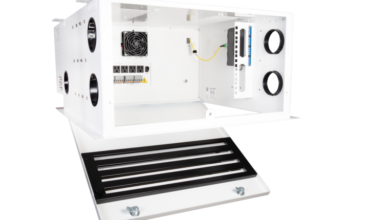Ehab Kanary, vice president of Enterprise, Middle East and Africa at CommScope describes the year 2019 as the year for digital transformation in the data center.
“Digital transformation” in the data center has achieved buzzword status among media and marketers everywhere, but there are real benefits to be gained from embracing the migration from manual, analog information systems to automated digital ones. Diverse companies like Boeing, Google, IBM and Uber achieve notable successes by embracing digital processes. CEOs of other companies are catching on.
According to IDC, annual spending on digital transformation (DX) initiatives in the Middle East, Turkey and Africa is set to cross the $20 billion (Dh73,4 bn) mark by the end of 2018. And, by 2020, the Middle East’s data centre spending and investment is expected to reach a new record high of $5 billion (Dh18 bn).
There will be more demand for digital transformation initiatives than ever before in 2019 because CEOs are finally realizing that for their companies to stay relevant, their businesses need to transform. As 5G networks and devices start to come online in 2019, this will drive several kinds of technology that will be needed. Data center managers simply need to be prepared. There are five technologies that will continue to significantly impact data centers in 2019: 5G wireless, the Internet of Things (IoT), virtual/augmented reality (VR/AR), blockchain, and artificial intelligence (AI). In this article, we’ll look at how these technologies support the trend toward digital transformation in the data center.
5G Wireless
In a very real sense, we’re moving toward the Internet of Everything, and the final link between devices and the network is likely to be wireless. 5G wireless technology delivers significantly higher data rates and significantly more data in many more places. Mobile workforces, from sales teams to delivery, maintenance and repair organizations, will all use more sophisticated applications that rely on faster and more reliable data transfers. And even employees at the office will use 5G services to rely even more heavily on their phones and other portable devices. For example, sales organizations are giving their reps videoconferencing capabilities, so prospects can view testimonials or product demonstrations and repair personnel are accessing videos that show the steps in a maintenance procedure. Two bigger examples are driverless cars and entire “smart cities” that require huge bandwidth.
While widespread deployment of 5G isn’t happening for at least a few years, data centers in 2019 have to prepare for it. Infrastructure must evolve to support higher wireless bandwidth and more ubiquitous data usage. Companies and building owners are looking beyond just Wi-Fi to enable strong and consistent in-building mobile wireless services with distributed antenna systems (DAS). In the outdoor environment, service providers are upgrading and expanding their fiber networks to carry wireless data back to the core of the network, or in many cases, to edge data centers for situations where local processing is required for low-latency applications like driverless cars or remote surgery. Technology like C-RAN (Cloud Radio Access Networks or Centralized Radio Access Networks) and edge computing will be implemented in 2019 to support 5G wireless services because there will be more data processed at the edges of the network.
IoT
One of the 5G use cases is to specifically support IoT applications. The MicroMarket predicts the UAE’s IoT market will more than triple, reaching $ 35 billion (Dh126 tn) by 2019. As companies deploy thousands or millions of wired and wireless sensors that produce large amounts of raw data, this data is turned into useful information providing value for the user. The processing of the data is being placed closer to the source to reduce the communication requirements. For example, beverage companies are providing dispensers with IoT sensors that can report on each machine’s usage and inventory and relay that information to an application that can schedule a re-order and delivery of new supplies. In this case the raw data triggers an action to replace the inventory and this is forwarded to the cloud as opposed to routine status messages that often contain no new useful information. Autonomous truck fleets now leverage the IoT to report location, fuel levels, weight, temperature and other metrics to an application that determines estimated delivery times, fuel stops, or cargo tracking.
To other emerging industrial IoT applications where production processes are controlled in real-time, the network infrastructure needs to have very low predictable latency and very high reliability. In 2019, data center operators will use augmenting intelligence in autonomous systems to make use of expanded peer to peer communications at the edge, which is new to 5G networks. Fiber optic infrastructure will provide reliable low-cost transmission capacity for edge data centers while placing edge data centers close to the IoT sensors and actuators will reduce transmission latency and transmission costs.
VR/AR
Augmented reality (AR) is the use of a device like a cell phone to display relevant data while the user is watching/doing something live. This year has seen an increase in AR as technicians hold phones while repairing a product to see a schematic of the product with instructions about how to make the repair. On the other hand, virtual reality (VR) is a complete immersion in a virtual world through the use of an audiovisual headset. For example, remote training classes are using VR headsets to learn production procedures before ever setting foot in a manufacturing facility.
While AR can be supported with today’s networks because the data is often downloaded to a handheld device, VR will require real-time video over an Internet communications link. If the connection is unreliable, bandwidth is too low, or latency is too high, the experience is degraded and may become useless. Enterprise communications are commonly video based. Video content is now originating from mobile devices. This new year will see higher-speed 5G networks designed to support peer to peer traffic with a greatly enhanced capability to support data generated at the end user device.
Blockchain
Blockchain is a decentralized database that is encoded, unchangeable, consensual, verifiable and permanent. When people hear “blockchain,” they think of Bitcoin, but there are myriad potential uses for the technology. It can and is being used for anything that requires a permanent, secure, and verifiable record that can be accessed in a decentralized fashion.
For logistics, blockchain is being used to establish trusted information such as where a product was made, when it was made, when it shipped, where it is located and arrived, and how it was used. It’s a shared public encryption system in which distributed users participate in the operation of the blockchain. Everyone holds the blockchain data with a reduced vulnerability to attack.
Anything that requires or can leverage a distributed ledger can benefit from Blockchain. It can be applied whenever an exchange of information needs to be recorded and verified, so it has the potential to disrupt many organizational functions, from finance and procurement to manufacturing, IT and sales. Because of the benefits, this technology will be increasingly adopted in 2019, which will impact the data centers housing the distributed ledgers.
AI
In the UAE, Artificial intelligence (AI) is expected to boost economic growth by 1.6 per cent, adding $182 billion (Dh 667,94 tn) to the national economy by 2035. However, AI has been slow to develop because many people start with the idea of a machine thinking like a human. Another reason AI has been slow to develop is that it has historically required massive computers to support it. However, this is now changing. The cost of computing has greatly decreased; AI algorithms have improved; edge computing has enabled AI to be deployed in new ways. This will continue and be more dramatic in 2019.
Developing the models to run AI is done on the large central cloud resources. This model is then downloaded to the edge layer where the execution of AI provides benefits in local time sensitive environments. The edge AI analyzes and controls the local process (for e.g.) and then feeds back information to the cloud helping to improve the higher layer model. Companies like Google and Facebook are using AI to refine facility operations, increasing availability, reducing operating complexity and cost.
To prepare for a continued AI push in 2019, corporations will adopt high-speed, low-latency networks coupled with high-end performance edge compute. Layering AI between local and centralized resources will combine the power of central cloud with the agility and performance of edge-based AI.
It’s About the Infrastructure
All of the technologies discussed have been around but are in the process of maturing and showing benefits that will bring about more adoption in 2019 and will force a digital transformation in the data center. To prepare for digital transformation, data center managers will implement advanced network infrastructures to make their networks faster, more ubiquitous, more reliable and more secure. By migrating to higher-speed networks, expanding the reach of fiber and wireless links, and adopting edge computing strategies, companies can lay a firm foundation for digital transformation in 2019.




